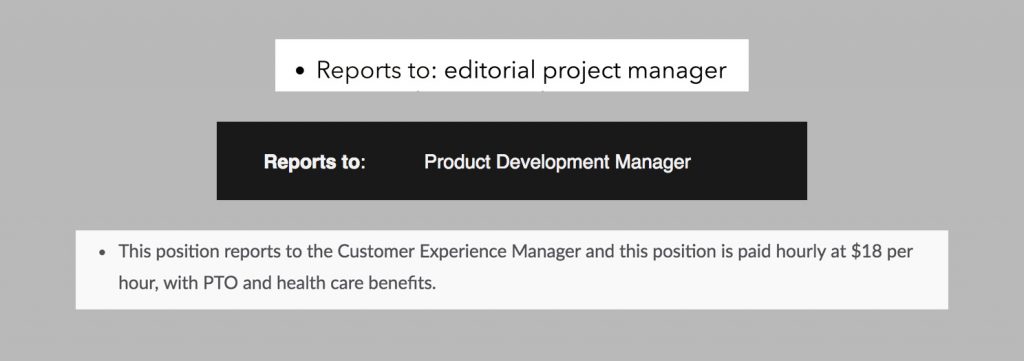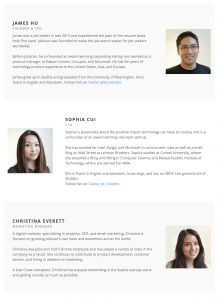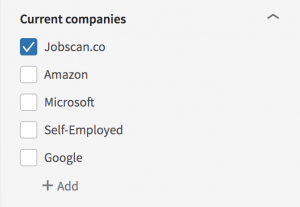In our modern age of personalization, To Whom It May Concern is both an antiquated and detached way to address a cover letter. It may also imply that you haven’t researched the company or that you assume the letter can be read by anyone. Below, we’ve put together a few tips to help you personalize your cover letter, whether you know the hiring manager’s name or not.
When it comes to addressing a cover letter, advice columns frequently spotlight these two pitfalls:
- Mistake 1: Failing to address your cover letter to a specific person
- Mistake 2: Addressing a cover letter to the wrong person
Most job postings don’t specify who will be reading your cover letter. This puts job seekers in a tricky situation. Fixing the first mistake could cause you to make the second. So what’s the best way to replace “To Whom It May Concern” on your cover letter?
Get instant feedback on your cover letter with Jobscan’s cover letter optimization tool. See it in action.
3 Key Tips for Addressing Your Cover Letter
1) Don’t Address Your Cover Letter to the Recruiter
For many job openings, the first person you need to impress is a corporate recruiter. That doesn’t mean you should address your cover letter to them.
“Recruiters do not read cover letters,” a long-time healthcare recruiter told Jobscan. “Bottom line.”
That might be an overstatement — most don’t, some do — but many recruiters would admit that they aren’t the intended audience of a cover letter. “It’s mostly for the hiring manager,” said a recruiter in the non-profit industry. “For us [recruiters], it’s just an extra step in an already elongated process.”
The healthcare recruiter agreed: “If you’re sending it straight to a hiring manager who’s looking at a much lower number of applicants, they might actually read that.”
2) Search for the Hiring Manager’s Name
The best way to personalize your cover letter is to address the hiring manager by name. However, it can be difficult to identify the hiring manager, and your educated guess could cause you to address your cover letter to the wrong person. Here are some tips for finding the hiring manager.
Search the Company Website
Few job postings list the hiring manager by name but many will tell you the position to which you’d be reporting.

With this information, a little detective work can reveal the name of the hiring manager.
Start off by browsing the company’s website. Look for an about page, company directory, or contact page. These pages are frequently linked at the very bottom of the website. Companies that feature employees on their about page make it much easier to figure out who will be reading your cover letter.

You can also try searching the website. If the website doesn’t have a built-in search bar, use this syntax in Google:
“[position you’ll be reporting to]” site:company website

This will reveal hard-to-find about pages or other mentions of the position in the company’s blog posts, press releases, and other pages.
Search LinkedIn
If a company doesn’t list the hiring manager on their website, LinkedIn is your next best resource.
Start off by searching for the company page on LinkedIn. Once you’re on the company’s LinkedIn page, click “See all X employees on LinkedIn” near the top.

Depending on the company size, you can either browse all positions or narrow your results by adding search terms to the search bar (e.g. “Marketing Manager”) and utilizing the “Current companies” filters on the right side of the screen.

Search for the “reports to” position from the job listing. If it wasn’t provided in the listing, search for keywords related to your prospective department (e.g. “marketing”). If the company uses an intuitive corporate hierarchy you should be able to determine who will be reading the cover letter.
Contact the Company Directly
There is nothing wrong with calling or emailing the company to ask for the name of the hiring manager. Be polite and honest with the administrative assistant or customer service representative. Explain that you’re about to apply for a job and you’d like to know who you should address in your cover letter.
If they aren’t able to provide an answer or transfer you to someone who knows, let it go. The last thing you need is word getting back to the hiring manager that you were pushy with one of their colleagues.
3) Use a More Personalized “To Whom it May Concern” Alternative
You can still personalize your cover letter, even when you don’t know the identity of the hiring manager. Instead of “To Whom It May Concern,” which casts a wide net and is specific to no one, try addressing your cover letter to one specific person.
The most generic version of this is:
Dear Hiring Manager,
But job seekers can often be more specific. Take a look at these examples:
Dear Customer Experience Manager,
Dear Customer Experience Hiring Team Manager,
Some other alternatives include addressing your cover letter to an entire department:
Dear Engineering Department,
Dear Engineering Team,
OR addressing the entire team:
Hi Jobscan Team,
Dear Jobscan Team,
As with many aspects of the job application process, demonstrating that you put in some extra effort can make a difference. Doing some research before addressing a cover letter contributes to a positive first impression.
8 cover letter salutation examples
Here are eight standard cover letter openings you can choose from. Select the one that best suits the energy of the company you’re applying to and use either a specific name or department depending on the information you have available.
- Hi Mr. Smith,
- Hello Jobscan Team,
- Dear Ms. Whittaker and Team,
- Good morning, Mr. Kennedy
- Dear Engineering Department,
- Good afternoon, Louise,
- To the Jobscan hiring manager,
- Greetings,
How to end a cover letter
Just as important as beginning your cover letter is ensuring you end it on a strong note. Your cover letter ending should not be underestimated in its ability to help you move forward in the hiring process. After making your case in the previous paragraphs, you need to end your cover letter with a strong call to action to entice the recruiter to invite you for a job interview.
Madeline Mann, an HR leader in the technology industry and creator of Self Made Millennial, says that while no conclusion will save a bad cover letter, it can distinguish you from another good candidate.
It’s all about enthusiasm, according to Madeline. “Companies want people who want them,” she says. If you can draw to the company’s values and show how interested in working with them you are, that’s a substantial advantage. You want to create a lasting impression by incorporating that enthusiasm in your cover letter ending.
“Companies want people who want them”
– Madeline mann
A good conclusion, in fact, should reflect the rest of your cover letter.
Set up the end of your cover letter with a strategic middle section
If you want your cover letter ending to be effective, you first need to build momentum. Most recruiters and career coaches agree that by the time you get to the end of your cover letter, it needs to possess the following three elements:
- It tells a story about yourself
- It shows your value concretely
- It calls the recruiter to action
Julia Reiter, a career coach based in Toronto, suggests that you lead up to your cover letter ending by showing that you understand the company’s current challenges and are equipped to solve them. This will make your cover letter call to action all the more effective.
Although the job description will give you information about what the company is looking to accomplish, it will not help you distinguish yourself from other applicants. Show the company you are willing to go the extra mile by researching the key industry challenges and the particular issues they might be facing (beyond the obvious ones).
For example, you can read articles from industry-related publications and get acquainted with the numbers and statistics about the particular business areas your company is engaged in. By being aware of the particular issues they are facing, you can more easily make your skillset and experiences relevant.
When you talk about your past experiences and accomplishments, make sure you mention the problems the company is facing. For example, if you are applying for a customer success manager position at a Software-as-a-Service company, a relevant issue might be high churn rates.
Instead of writing something like “my experience in customer success makes me confident I will be a great addition to your team,” write something like “When I worked at XYZ company, I was able to reduce the churn rate by 30%. With this experience and my deep knowledge of B2B consumer psychology, I am prepared to ensure we have one of the lowest churn rates in XYZ industry.”
End your letter with a call to action
You may be tempted to write that “I’m looking forward to hearing from you” for your cover letter ending. That isn’t a call to action. For Madeline, the end of a cover letter serves to give one last push and show interest and enthusiasm in a way that stands out.
Likewise, Julia says, “now that the company knows you are aware of their current challenges and are equipped to solve those challenges for them, don’t leave them hanging. Tell them how they can make your skills and experiences a reality on their team. What number can they reach you at for an interview?”
How do you conclude a cover letter? Here are 3 examples
- “I’m excited to have the opportunity to talk about how I could join your team in its quest for XYZ value. I’m particularly thrilled about XYZ project and would love to know how I can contribute to it.
- “I am keen on meeting with you to see what I can contribute to XYZ company as it moves on in its journey to XYZ goal. I am available at your convenience for a phone call or in-person meeting.”
- “I would love to get your thoughts on what I mentioned. I am happy to hop on a phone call at your earliest convenience to discuss how I can help XYZ company with XYZ issue.”
Mistakes to avoid when ending a cover letter
The mistakes people make when they end their cover letter are often the same ones they made earlier in the piece. However, they can be particularly detrimental to your chances of landing an interview if they constitute the final impression a recruiter has of you.
When ending a cover letter, avoid:
Making it about yourself instead of the company: use sentence constructions that make the recruiter see how the company is going to benefit from hiring you. For example, try to use “you” or “we” instead of “I.”
Sounding generic or robotic: we’ve all seen these cover letters that end with the same plain paragraph. If you write one of those, the last impression you’re giving is not different from those given by all other applicants.
Selling yourself short: the conclusion is your last chance to show off the value you can bring to the company. Emphasize it and use it as a segue into your call to action.
How to end a cover letter with the appropriate salutations
Always remember that recruiters review hundreds of applications for each position. When you are competing with that many candidates, the slightest mistake will disqualify you immediately Although you may not think too much of the salutations, they can hurt your chance of landing an interview.
Make sure your salutations are formal and polite. You should be respectful not only by indicating your appreciation of the recruiter’s time but also by being concise. Do not overdo your salutations and do not employ informal greetings. “Sincerely,” “Thank you for your consideration,” “kind regards,” are all safe options.
When ending your cover letter, you want to balance confidence, respect, and appreciation.
17 cover letter ending examples
Depending on the energy of the business you are applying to, and your own personality, select one of the following 17 cover letter closing options.
- Best,
- Best wishes,
- Thank you,
- Sincere thanks,
- Many thanks,
- Thanks in advance,
- Thank you for your consideration,
- Thank you for your time,
- Respectfully,
- Sincerely,
- Sincerely yours,
- Yours truly,
- Regards,
- Kind regards,
- With best regards,
- Looking forward to speaking with you,
- With gratitude,
One Final Important note: Cover letters aren’t what they say they are
Cover letters don’t introduce your resume, they supplement it.
In order to get your cover letter into the hands of a hiring manager who cares, your resume has to get past the recruiter and, in many cases, the applicant tracking system they’re using.
Try analyzing your resume below to receive instant optimization tips and recruiter insights from Jobscan so that the time you spend crafting your cover letter isn’t a waste.
The keyword analysis also shows exactly what to focus on in your cover letter.
Jobscan Premium (one month free) even has a cover letter scan feature.
Editor’s Note: A section of this article was originally written in a separate blog post by Léandre Larouche on June 9, 2020. It has been updated and combined with this article as of June 10, 2021.

















